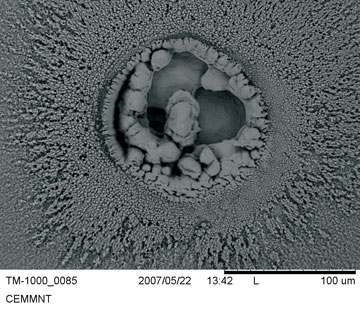|
NEWS NOTES
Deep Earth
How does your continent grow?
 Graham Pearson |
| Osmium isotopes in a grain of osmiridium (shown here), an erosion-resistant mineral found in ancient mantle rocks called ophiolites, reveal mantle ages that suggest Earth’s continental crust was extracted from the mantle in several large pulses. |
Scientists think that Earth’s continental crust formed from melted rocks extracted from the planet’s mantle. How and when that extraction occurred, however — whether it happened gradually, in several large pulses or all at once — has been a matter of considerable debate. Now, data from ancient mantle rocks are helping to shore up the hypothesis that the continental crust was extracted in pulses, during periodic large melting events in the mantle.
The oldest rocks found on Earth exist at the heart of many continents in ancient, stable, undeformed rock formations called cratons. Zircon crystals in these rocks contain isotopes of uranium and lead, whose ratios can tell the time of the crystals’ formation. Rather than an even distribution of ages, as might be expected if the crust had formed gradually through time, the rocks’ ages have tended to cluster in peaks at 1.2 billion, 1.9 billion, 2.7 billion and 3.3 billion years old. That has lent support to the idea that the crust formed in pulses — but could also mean that those rocks have been preserved, while rocks of other ages eroded away, according to geochemist Graham Pearson of Durham University in the United Kingdom. “It’s difficult to unequivocally dismiss those options,” Pearson says.
Pearson and his colleagues took a different approach to the problem. “We decided to look in the mantle itself,” he says. Because the crust was originally extracted from the mantle, the mantle should also bear the isotopic signature of that extraction, in reverse, he says. Those chemical signatures are the result of the different preferences for some elements and their isotopes to be in magma rather than remaining behind in solid rocks. The difficulty with looking for the signature in the mantle, however, is that
materials are continuously being recycled in the mantle, and such isotopic signatures are continuously being reset or diluted, he says.
“Very few isotope systems will preserve this,” Pearson says. However, one isotope system — comprised of parent isotope rhenium-187, which radioactively decays to osmium-187 — is “much more reliable” in terms of preserving evidence of these melting events, he says. Unlike most parent-daughter isotope systems, the parent rhenium isotopes prefer to enter the melt, while osmium remains behind in the solid mantle rock. Taking large amounts of melt out of the mantle also removes much of the parent isotope, effectively “freezing” the radiogenic clock, he says. With this isotope system, “we have the potential to look at a spectrum of old mantle melting events that are frozen in time,” Pearson says.
To link the ages of mantle melting events to ages of crust formation determined from zircons, the team looked at the osmium ratios in robust minerals called osmiridium, found in ancient mantle rocks called ophiolites. Compiling new ratios from ophiolites in the Urals, Tasmania and Tibet with already existing rhenium-osmium data from other ophiolites and peridotites around the world, the team built up a statistical picture of ages of melting events. Although the total range of ratios and the consequent ages varied widely, the data clustered around peaks at 1.2 billion, 1.9 billion and 2.7 billion years old, they reported Sept. 13 in Nature. Furthermore, they noted, those peaks, which reflect times of mantle melting events, compare closely with the continental ages known from zircons.
The study represents the first time a direct signature of crust extraction from the mantle has been observed, Pearson says. “The fact that we look in the mantle and find completely independent evidence of melting events lends what we think is strong support” to the idea that the zircon ages represent large pulses of crust formation, he adds.
Showing that it is possible to date mantle rocks with this new method, and comparing them to zircon ages, has been a key step to pinning down continental crust formation, says Kent Condie, a geochemist at New Mexico Tech in Socorro. “It’s an interesting proposition,” he says. “The fact that he has that peak at 2.7 billion years certainly corresponds to a time when a lot of continental crust appeared.” However, much of the existing data on mantle signatures is from one craton in South Africa, while the database of zircon-derived crustal ages is quite large, he says. “We don’t have good geographic coverage [for mantle ages], so we can’t really say that this applies to all continents yet.”
Still, Condie says, the method is a “breakthrough,” particularly in its ability to examine very small grains for these isotopes and get precise numbers. The trick will be to locate the right mantle rocks in the right places, he says.

 Subscribe
Subscribe


